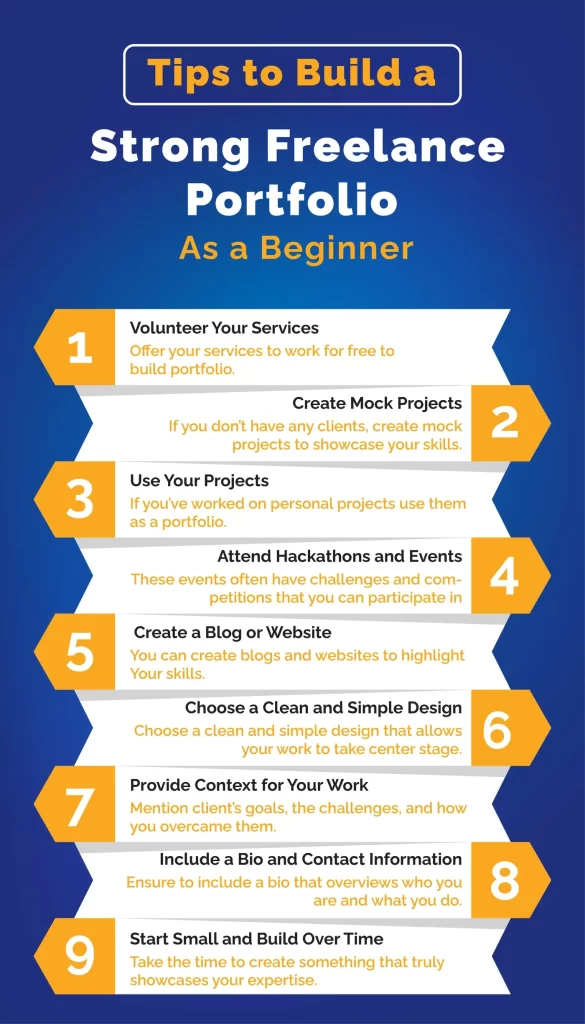As a freelancer, your portfolio is essential for showcasing your freelance skills. But the question is how to build a strong freelance portfolio. And why is everyone asking for the portfolio? A portfolio is the best visual representation of your work.
A portfolio can be likened to a garden that an investor cultivates and nurtures over time. Just as a well-tended garden can provide beauty, nourishment, and a sense of accomplishment to a gardener, a well-managed portfolio can provide growth and income. Also, it is a sense of financial security for an investor.
The worth of a portfolio, like a garden, is not just measured in size or quantity. It is measured for the quality and diversity of its holdings and the care and attention it receives over time. A portfolio could make or break your chances of getting hired. So, you’ve to know how to build a strong freelance portfolio.
It will help you to build a name in the freelancing world. And you can attract businesses to work with them.
But Why Do Freelancers Need a Portfolio?
Freelancers must need a strong portfolio. Certainly! A portfolio is an essential tool for freelancers for several reasons.
Firstly, a portfolio allows freelancers to showcase their skills. In a portfolio, they can easily see the quality and scope of the freelancer’s work. When someone works remotely, meeting with clients in person is impossible.
Secondly, a portfolio helps freelancers stand out from the competition. And a strong portfolio can help them differentiate themselves from others in their field. A well-curated portfolio demonstrates the freelancer’s unique style and skill set. Also, the experience can make a lasting impression on potential clients.
Thirdly, a portfolio is an excellent way to demonstrate a freelancer’s creativity. It will help with problem-solving abilities. Potential clients can see the freelancer’s ability to approach a project. They can easily find innovative solutions to problems.
It helps to build trust and confidence in the freelancer’s ability. And deliver high-quality work.
Finally, a portfolio can help freelancers attract the right clients. By showcasing their past work, freelancers can attract clients who appreciate their style, skillset, and experience.
It leads to fruitful relationships between the freelancer and the client.
In summary, a portfolio is important for freelancers. It allows new freelancers to showcase their skills and experience. As well it demonstrates their creativity and problem-solving abilities.
With all this, it helps to attract the right clients. A freelancer could build a strong portfolio by investing time and passion. A strong portfolio helps build a thriving freelance business as a reward.
How To Build a Strong Freelance Portfolio As a Beginner?

At the start of the freelance career, it is challenging to build a strong portfolio. But we’ve solutions. Here’re some tips that will help you to build your portfolio.
Here are some tips that help you to make a portfolio as a beginner:
Volunteer Your Services:
You can Volunteer your services to build a strong portfolio, as it is one of the best and easiest ways to build a portfolio. For this, you’ve to look for non-profit organizations or local businesses. Offer your services and offer to work for free.
Create Mock Projects:
If you don’t have any clients, create mock projects to showcase your skills. You can design a logo or create a website. And you can write a blog post to showcase your writing. These projects will give potential clients a sense of your style and capabilities.
Use Your Projects:
If you’ve worked on personal projects, use them to showcase your skills. For example, if you’re a graphic designer, you could showcase a personal project you created.
And you can share your work with different social groups.
Attend Hackathons and Events:
Attending hackathons (social coding events) and events related to your field are great ways to build a portfolio. These events often have challenges and competitions that you can participate in to showcase your skills.
Create a Blog or Website:
You can create blogs and websites to build your portfolio. Highlight your skills and highlight your past work. It is an effective way to offer your services to potential clients.
Choose a Clean and Simple Design:
There’s often more to be said about design when less is more. Choose a clean and simple design that allows your work to take center stage. Avoid cluttered or overly complicated designs.
Provide Context for Your Work:
When showcasing your work, it’s essential to provide context. It could include details on the client’s goals, the challenges you faced, and how you overcame them. Providing context helps potential clients understand the scope of the project and your role in it.
Include a Bio and Contact Information:
Ensure to include a bio that overviews who you are and what you do. It helps potential clients get to know you and your background.
With all this, add your contact information and share your social profiles.
Start Small and Build Over Time:
Creating a strong portfolio takes time, so feel free to have everything perfect. Start small and build your portfolio over time, adding new projects and refining your design.
Remember, your portfolio reflects your skills and abilities. So, take the time to create something that truly showcases your expertise.
My Final Verdict:
A strong portfolio as a beginner requires focus, creativity, and patience. You can create the best portfolio by identifying your niche and showcasing your best work. Because a simple and easy-to-navigate portfolio helps you to win potential clients. As it is your first impression.
Platforms to Arrange the Freelance Portfolio Work in Easy-to-Navigate Style
You can use several platforms to arrange your portfolio work in an easy-to-navigate style.
Here are a few popular options:
- Behance: an online platform that allows designers to showcase their work. It’s free to use. You can use it to easily navigate your work.
- Dribbble: a platform where you can show your digital designs worldwide. By using this, you can connect with other designers. And can win potential jobs.
- Squarespace: Squarespace is a website builder offering a portfolio template perfect for freelancers. The templates are easy to customize. Freelancers use this site to build a professional portfolio.
- Wix: Wix is another website builder offering various portfolio templates. It offers several customization options. It makes it easy to create a unique portfolio.
- WordPress: WordPress is a popular content management system that offers several portfolio themes. It has both free and pro features to make it easy to use. Its themes are easy to customize. It’s best to use for a professional-looking portfolio.
- Medium: Freelance writers can showcase their expertise on Medium by publishing and sharing articles on social media. It can attract potential clients and establish them as experts in their field.
8 Tips on What Freelancers Should Include in Their Portfolio
Once you’ve created your portfolio, you must ensure it effectively showcases your skills and capabilities.
Here are some tips on what you should include in your portfolio:
Tip#1: A clear and concise introduction:
Your introduction should provide an overview of yourself and what you do. It shows your specialized area of work. It could include a summary of your skills, experience, and background.
Tip#2: Ensure your introduction is clear and concise
It should be clear and captures the attention of potential clients immediately.
Tip#3: Your best work:
Selecting your best work can be challenging, but showcasing projects demonstrating your skills and abilities is important.
Choose projects relevant to the type of work you want to do in the future that demonstrates various skills and styles.
It’s also essential to present your work in an engaging and visually appealing way.
Tip#4: Client testimonials:
Client testimonials are a powerful way to build trust with potential clients. You’ve to choose testimonials that highlight your strengths. And with all this demonstrates your ability to deliver high-quality work.
Make sure to include the client’s name, company, and photo. It helps add credibility to the testimonial.
Tip#5: Your Process:
Providing information about your process can help potential clients understand how you work and what they can expect when working with you.
It could include details about your communication style, project management, and workflow. It helps your clients feel more confident in working with you.
Tip#6: Contact information:
You can also include a contact form on your portfolio website. It includes your email address, phone number, and social media profiles. Make sure your contact information is prominently displayed and easy to find.
Tip#7: Your unique value proposition:
Your unique value proposition sets you apart from other freelancers in your field. It could include your project approach, attention to detail, or exceptional communication skills.
Remember to highlight your unique strengths and what makes you the best choice for potential clients. It helps you stand out from the competition and attract the right clients.
Tip#8: Show your process with case studies:
In addition to highlighting your process, consider creating case studies that dive deeper into a specific project.
It could include details on the client’s goals, the challenges you faced, and how you overcame them.
By providing a detailed look at your process, you’ll be able to demonstrate your problem-solving abilities and show potential clients how you approach projects.
Tip#9: Highlight your ongoing education:
Techniques As a freelancer, staying up-to-date with your field’s latest trends is essential. Consider highlighting any courses or certifications you’ve completed or any conferences or events you’ve attended.
It demonstrates your commitment to ongoing education and professional development and can help build trust with potential clients.
In summary, each tip requires careful consideration and attention to detail. By following these tips you can create the best portfolio to showcase your skill and work experience.
FAQ’s
What types of work should I include in my portfolio?
You should include relevant work for your skill. It could include projects you’ve completed for clients, personal projects, or even school projects. Choose your best work and showcase a range of skills and styles.
How many pieces of work should I include in my portfolio?
It’s better to have fewer high-quality pieces than a more significant number of mediocre pieces. Generally, aim for 8-12 pieces that showcase your best work and highlight your range of skills and styles.
How often should I update my portfolio?
It’s essential to update your portfolio regularly, especially if taking on new projects or developing new skills. Aim to update your portfolio at least once every six months or as needed.
Should I include pricing information in my portfolio?
It’s generally optional to include pricing information in your portfolio. Instead, focus on showcasing your work and highlighting your skills and abilities. You can discuss pricing with potential clients during the proposal or negotiation phase.
Should I create a physical portfolio or a digital portfolio?
Creating a digital portfolio is generally more practical in today’s digital age. It allows potential clients to view your work easily from anywhere in the world.
However, suppose you work in a field that requires physical samples (such as photography or graphic design).
For this, you’ve to create a physical portfolio in addition to a digital one.
How can I make my portfolio stand out?
Focus on showcasing your unique skills and abilities to make your portfolio stand out. Consider adding case studies or personal projects demonstrating your problem-solving abilities and creativity. Additionally, ensure your portfolio has a clean, straightforward design that allows your work to take center stage.
Should I include testimonials in my portfolio?
Testimonials can be a powerful addition to your portfolio, demonstrating your successful track record and ability to satisfy clients. Consider adding testimonials from previous clients or colleagues to showcase your professionalism and expertise.
Should I include a resume or CV in my portfolio?
You can leave a partial resume or CV. Including a summary of your skills and experience in your portfolio is generally ideal.
You have to highlight your best work. Remember, make your portfolio easy for clients to see why you’re a good fit for their project.
How can I make my portfolio more engaging?
To make your portfolio more engaging, consider adding interactive elements. Such as you can use videos or animations, to showcase your work.
You can also use storytelling techniques to explain your creative process. It helps you to build a more engaging portfolio.
How can I get feedback on my portfolio?
Consider sharing your portfolio with colleagues, mentors, or other freelancers in your field for feedback. You can also ask for feedback from potential clients by including a brief survey or questionnaire with your portfolio.
I hope these FAQs help!
Building a strong portfolio can be challenging. But you can create the best portfolio by focusing on your best work and updating regularly. You can do this by showcasing your unique skills and abilities.
Conclusion “How to Build a Strong Freelance Portfolio?”
A strong freelance portfolio is essential to attract clients. Volunteer, create mock projects, attend events and use platforms like Behance or WordPress to showcase your work.
Include an introduction, your best work, testimonials, process, and contact information. All this stands out from the competition with a professional and well-organized portfolio.





